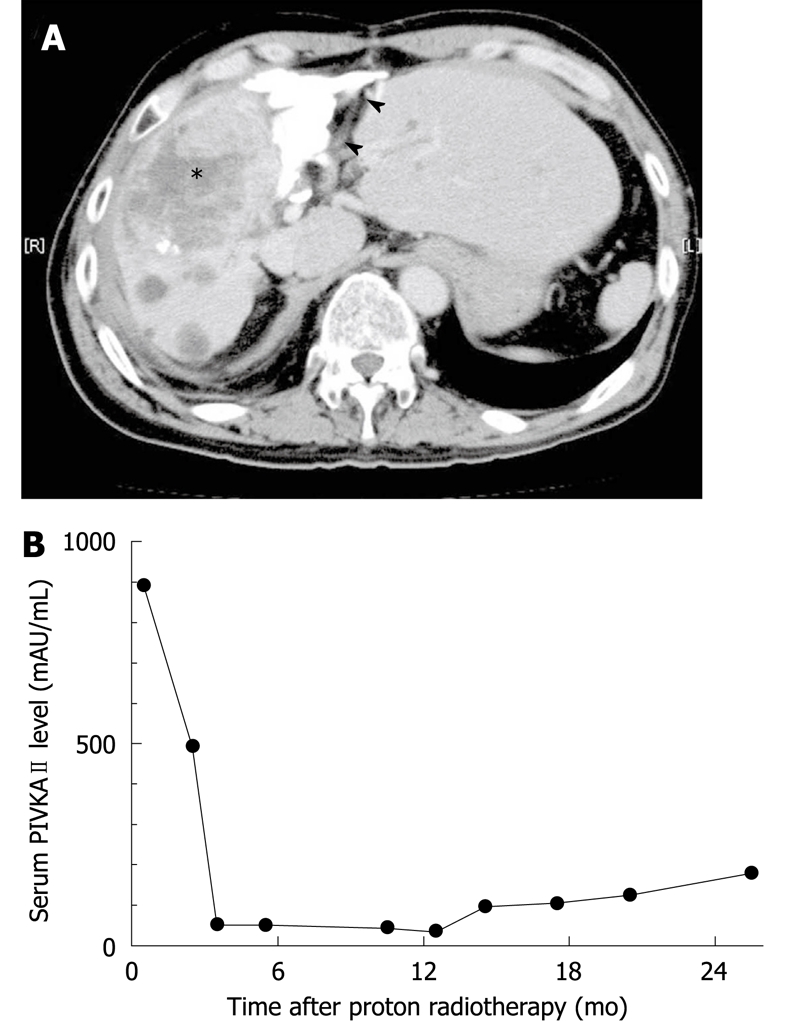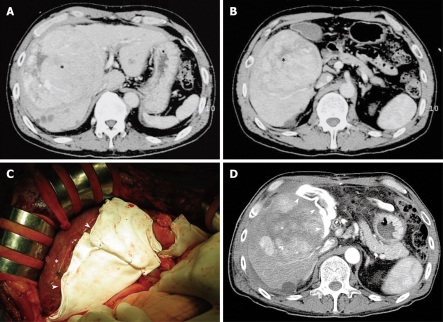Abstract
Few potentially curative treatment options exist apart from hepatic resection for patients with huge hepatocellular carcinoma (HCC). Proton radiotherapy is a promising new modality which has an inherent anti-tumor effect against HCC. However, the application of proton radiotherapy for tumors adjacent to the gastrointestinal tract is restricted because the tolerance dose of the intestine is extremely low. A novel two-step treatment was developed with surgical spacer placement and subsequent proton radiotherapy to administer proton radiotherapy with curative intent. This report presents a case of a patient with a huge unresectable HCC treated by this method who achieved disease-free survival of more than 2 years. This new strategy may potentially be an innovative and standard therapy for unresectable HCC in the near future.
Keywords: Hepatocellular carcinoma, Proton radiotherapy, Particle radiotherapy, Operative surgical procedures
INTRODUCTION
Hepatocellular carcinoma (HCC) accounts for between 85% and 90% of primary liver cancer and is one of the most frequent malignancies[1]. Currently, several treatment modalities are available for the treatment of patients with HCC, including hepatic resection, liver transplantation, transarterial chemoembolization (TACE), percutaneous ethanol injection, percutaneous microwave coagulation therapy, radiofrequency ablation, and radiotherapy[2,3]. Although TACE is the only nonsurgical treatment option for HCC measuring above 10 cm × 10 cm, the 5-year survival rate is less than 10%, and its efficacy remains uncertain[4]. At present, a hepatic resection is regarded as the only curative treatment for a huge HCC, if the patient’s hepatic functional reserve is acceptable for resection[5,6].
Proton radiotherapy is a new mode of radiotherapy that has an inherent advantage over photon radiotherapy. Owing to the defined range of protons exhibited by the Bragg peak, they allow reduction of the irradiated volume and the dose administered to the normal tissues[7,8]. Recently, many reports have demonstrated the effectiveness and safety of proton radiotherapy and it has become an acceptable modality for various malignancies including HCC[7-9]. However, the application of proton radiotherapy for huge HCC is restricted because most of these lesions are in contact with the gastrointestinal tract that cannot tolerate a radical dose of proton beams[10,11]. Recently, we developed a novel 2-step treatment with surgical spacer placement and subsequent proton radiotherapy[12]. In this case report, we employed this strategy for a huge unresectable HCC and achieved a long-term survival benefit without recurrence.
CASE REPORT
A 59-year-old male was referred for the treatment of a huge HCC in the right lobe of the liver. He had developed hepatitis B 50 years earlier and received no medical treatment. A physical examination revealed general fatigue and abdominal distension as a result of the huge tumor. Abdominal computed tomography (CT) showed a massive tumor, measuring 12 cm × 12 cm, occupying a wide area of the right lobe (Figure 1A). There was no sign of tumor vascular invasion in the hepatic or the portal vein and the tumor broadly abutted the gastrointestinal tract on CT images (Figure 1B). Liver function tests showed a total bilirubin of 1.0 mg/dL, aspartate aminotransferase of 33 IU/L, alanine aminotransferase of 24 IU/L, prothrombin time-international normalized ratio of 1.16, and an indocyanine green retention rate at 15 min of 19.6%. Serological analysis showed that the serum level of α-fetoprotein and PIVKAII (protein induced by vitamin K absence II) were 3.7 ng/mL and 3910 mAU/mL, respectively. There was no regional lymph node metastasis. A right trisegmentectomy was not acceptable judging from the criteria for a safe hepatic resection[13]. Proton radiotherapy with curative intent also was not acceptable since the tumor was located broadly adjacent to the gastrointestinal tract. Therefore, a novel 2-step treatment was employed with surgical spacer placement and subsequent proton radiotherapy[12]. Eight Gore-Tex sheets (20 cm × 15 cm × 2 mm) were superimposed and applied as a spacer and sutured tightly to the inferior surface of the liver to keep the gastrointestinal tract away from the tumor (Figure 1C). No part of the tumor was resected during the spacer placement surgery, because it was just a first step to allow proton radiotherapy. Abdominal CT after the operation showed the spacer maintained a sufficient open space between the tumor and the gastrointestinal tract (Figure 1D). The postoperative course was uneventful and 1 mo later, proton beams of 84GyE were administered in 20 fractions over 30 d (Figure 2). No acute or late treatment-related toxicities (grade 2 or more) were observed and liver function was unchanged for up to 2 years after the proton radiotherapy. In addition, abdominal CT showed regression of the tumor. Areas of high signal intensity on the CT images correlated with liquefaction necrosis, granulation tissue, and the tumor (Figure 3A). Notably, the serum PIVKAII level remained within normal limits for up to 2 years, indicating no sign of recurrence, consistent with other modalities (Figure 3B). As there was no convincing evidence for the safety of hepatic resection after proton radiotherapy, we decided not to perform any surgery even after shrinkage of the tumor.
Figure 1.
A huge tumor occupying a wide area of the right lobe. A: Abdominal computed tomography (CT) showing a pre-treatment dominant lesion located widely in the right lobe (asterisk); B: The tumor (asterisk) has extended contact with the gastrointestinal tract; C: Intraoperatively, Gore-Tex sheets (arrowheads) maintained a space between the tumor (asterisk) and the gastrointestinal tract (under the fingertips); D: Post-operative abdominal CT showing the spacer (arrowheads) around the tumor (asterisk); the spacer maintained a sufficient open space between the tumor and the gastrointestinal tract.
Figure 2.

Treatment plan for proton radiotherapy with a total dose of 84 GyE in 20 fractions. A: Isodose curves demonstrate 100% of the prescribed dose at the center and decreasing by 10% of the dose from the inside out; B: Dose-volume histogram of the target volume and the intestine shows that the tumor is entirely irradiated by almost 100% of the prescribed dose, and the intestine is hardly irradiated.
Figure 3.

Two years after the proton radiotherapy abdominal CT reveals distinct shrinkage of the tumor (asterisk). Arrowheads indicate the gastrointestinal tract (A) along with reduced serum levels of the tumor marker, PIVKAII (protein induced by vitamin K absence II) (B).
DISCUSSION
Among various malignancies, HCC is one of the most suitable malignancies for the treatment of particle radiotherapy with several excellent treatment results[7,14,15]. However, the application of particle radiotherapy for tumors adjacent to the gastrointestinal tract is restricted because the tolerance dose of the intestine is extremely low[14,16]. An adequate margin of more than 10 mm is absolutely necessary for the administration of full-dose irradiation[17].
There have been many reports describing surgical methods for removal of the gastrointestinal tract from the irradiation field to prevent radiation-induced gastrointestinal damage during conventional photon radiotherapy[10,11]. However, the dose distribution of photon beams is generally inadequate for local tumor control, and the impact of combination therapy with surgery and subsequent photon radiotherapy has remained uncertain. Unlike conventional photon radiotherapy, proton radiotherapy is considered a curative treatment. Tumors can be controlled at a high rate as long as a sufficient dose can be administered. The 2-step treatment is an evolving strategy that enables the delivery of a sufficient dose to the tumor.
Curative treatments for HCC are limited to hepatic resection, liver transplantation and local ablative therapies[3]. In addition, in the absence of other treatment options, hepatic resection is the only treatment modality for a huge HCC that can produce notable survival, but the 5-year survival rate is only 16.7%-33%[6]. There was no possibility of treating this case in a curative manner or achieving disease-free survival of more than 2 years using a conventional strategy. The 2-step treatment achieved complete local control of the huge primary HCC and excellent disease-free survival. Surgical spacer placement can maintain a safety margin from the gastrointestinal tract and full-dose particle radiotherapy can be achieved without serious toxicities under that condition. It is highly important in terms of a new option for curative treatment of a huge unresectable HCC. This new strategy might potentially be an innovative and standard therapy for unresectable HCC in the near future.
Footnotes
Peer reviewer: Gianpiero Gravante, MD, BsC, MBBS, Department of Hepatobiliary and Pancreatic Surgery, Leicester General Hospital, Flat 38, Room 8, Hospital Close, Leicester, LE5 4WU, United Kingdom
S- Editor Wang JL L- Editor Cant MR E- Editor Zheng XM
References
- 1.Kim SR, Kudo M, Hino O, Han KH, Chung YH, Lee HS. Epidemiology of hepatocellular carcinoma in Japan and Korea. A review. Oncology. 2008;75 Suppl 1:13–16. doi: 10.1159/000173419. [DOI] [PubMed] [Google Scholar]
- 2.Llovet JM. Updated treatment approach to hepatocellular carcinoma. J Gastroenterol. 2005;40:225–235. doi: 10.1007/s00535-005-1566-3. [DOI] [PubMed] [Google Scholar]
- 3.Llovet JM, Bruix J. Novel advancements in the management of hepatocellular carcinoma in 2008. J Hepatol. 2008;48 Suppl 1:S20–S37. doi: 10.1016/j.jhep.2008.01.022. [DOI] [PubMed] [Google Scholar]
- 4.Poon RT, Ngan H, Lo CM, Liu CL, Fan ST, Wong J. Transarterial chemoembolization for inoperable hepatocellular carcinoma and postresection intrahepatic recurrence. J Surg Oncol. 2000;73:109–114. doi: 10.1002/(sici)1096-9098(200002)73:2<109::aid-jso10>3.0.co;2-j. [DOI] [PubMed] [Google Scholar]
- 5.Yeh CN, Lee WC, Chen MF. Hepatic resection and prognosis for patients with hepatocellular carcinoma larger than 10 cm: two decades of experience at Chang Gung memorial hospital. Ann Surg Oncol. 2003;10:1070–1076. doi: 10.1245/aso.2003.03.072. [DOI] [PubMed] [Google Scholar]
- 6.Lee SG, Hwang S, Jung JP, Lee YJ, Kim KH, Ahn CS. Outcome of patients with huge hepatocellular carcinoma after primary resection and treatment of recurrent lesions. Br J Surg. 2007;94:320–326. doi: 10.1002/bjs.5622. [DOI] [PubMed] [Google Scholar]
- 7.Schulz-Ertner D, Tsujii H. Particle radiation therapy using proton and heavier ion beams. J Clin Oncol. 2007;25:953–964. doi: 10.1200/JCO.2006.09.7816. [DOI] [PubMed] [Google Scholar]
- 8.Brada M, Pijls-Johannesma M, De Ruysscher D. Proton therapy in clinical practice: current clinical evidence. J Clin Oncol. 2007;25:965–970. doi: 10.1200/JCO.2006.10.0131. [DOI] [PubMed] [Google Scholar]
- 9.Halperin EC. Particle therapy and treatment of cancer. Lancet Oncol. 2006;7:676–685. doi: 10.1016/S1470-2045(06)70795-1. [DOI] [PubMed] [Google Scholar]
- 10.Burnett AF, Coe FL, Klement V, O'Meara AT, Muderspach LI, Roman LD, Morrow CP. The use of a pelvic displacement prosthesis to exclude the small intestine from the radiation field following radical hysterectomy. Gynecol Oncol. 2000;79:438–443. doi: 10.1006/gyno.2000.5965. [DOI] [PubMed] [Google Scholar]
- 11.Sezeur A, Martella L, Abbou C, Gallot D, Schlienger M, Vibert JF, Touboul E, Martel P, Malafosse M. Small intestine protection from radiation by means of a removable adapted prosthesis. Am J Surg. 1999;178:22–25; discussion 25-26. doi: 10.1016/s0002-9610(99)00112-9. [DOI] [PubMed] [Google Scholar]
- 12.Fukumoto T, Komatsu S, Hori Y, Murakami M, Hishikawa Y, Ku Y. Particle beam radiotherapy with a surgical spacer placement for advanced abdominal leiomyosarcoma results in a significant clinical benefit. J Surg Oncol. 2010;101:97–99. doi: 10.1002/jso.21417. [DOI] [PubMed] [Google Scholar]
- 13.Miyagawa S, Makuuchi M, Kawasaki S, Kakazu T. Criteria for safe hepatic resection. Am J Surg. 1995;169:589–594. doi: 10.1016/s0002-9610(99)80227-x. [DOI] [PubMed] [Google Scholar]
- 14.Kawashima M, Furuse J, Nishio T, Konishi M, Ishii H, Kinoshita T, Nagase M, Nihei K, Ogino T. Phase II study of radiotherapy employing proton beam for hepatocellular carcinoma. J Clin Oncol. 2005;23:1839–1846. doi: 10.1200/JCO.2005.00.620. [DOI] [PubMed] [Google Scholar]
- 15.Chiba T, Tokuuye K, Matsuzaki Y, Sugahara S, Chuganji Y, Kagei K, Shoda J, Hata M, Abei M, Igaki H, et al. Proton beam therapy for hepatocellular carcinoma: a retrospective review of 162 patients. Clin Cancer Res. 2005;11:3799–3805. doi: 10.1158/1078-0432.CCR-04-1350. [DOI] [PubMed] [Google Scholar]
- 16.Ishikawa H, Tsuji H, Kamada T, Hirasawa N, Yanagi T, Mizoe JE, Akakura K, Suzuki H, Shimazaki J, Tsujii H. Risk factors of late rectal bleeding after carbon ion therapy for prostate cancer. Int J Radiat Oncol Biol Phys. 2006;66:1084–1091. doi: 10.1016/j.ijrobp.2006.06.056. [DOI] [PubMed] [Google Scholar]
- 17.Mayahara H, Murakami M, Kagawa K, Kawaguchi A, Oda Y, Miyawaki D, Sasaki R, Sugimura K, Hishikawa Y. Acute morbidity of proton therapy for prostate cancer: the Hyogo Ion Beam Medical Center experience. Int J Radiat Oncol Biol Phys. 2007;69:434–443. doi: 10.1016/j.ijrobp.2007.03.009. [DOI] [PubMed] [Google Scholar]



